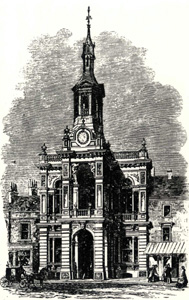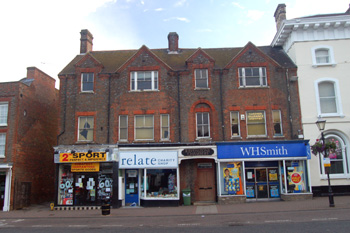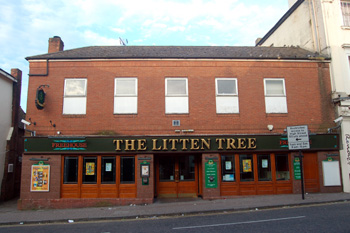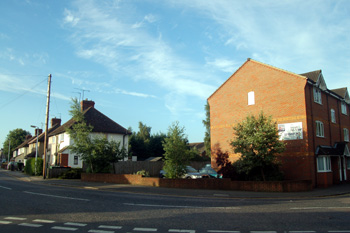Other Leighton Buzzard Licensed Premises
The following inns, public houses and beerhouses are known to have existed in Leighton Buzzard but Bedfordshire and Luton Archives and Records Service has very few records for each of them.
The Manor of Leighton Buzzard alias Grovebury was the principal landowner in the town before the 19th century. Bedfordshire & Luton Archives & Records Service has a full run of court rolls from 1393 to 1727 [KK619-715] and another full run from 1704 to 1867 [X288/1-23]. The service also has court rolls for other manor to own land in the town, the Prebendal Manor, from 1448 to 1459, 1588 to 1591, 1611 to 1622, 1627 and 1631 [KK792-1798]. Detailed study of these would be bound to produce quite full histories for most licensed premises in the town. Unfortunately such study would take a very long time. Thus the histories of the older licensed premises on this web page could, potentially, be added to and other, currently unknown, establishments brought to light with extensive future study.
The Agricultural Public House: Lake Street, Leighton Buzzard
This public house must have been short-lived. It is only mentioned in the Post Office Directory for 1869 when John Jones was licensee. Censuses show that in 1861 Jones was a steel pan maker in Workhouse Lane, now Baker Street. By 1871 he was a printer in the High Street. The Agricultural is not mentioned in either census. It is not known where the establishment was located in Lake Street.
List of Licensees: note that this is not a complete list; entries in italics refer to licensees where either beginning or end, or both, dates are not known:
1869: John Jones
The Black Bull: North Street, Leighton Buzzard
There is a stray mention of the Black Bull in vestry minutes regarding implementation of lighting in the town in 1839 [CRT130Lei5]: “adopted and carried into execution in such parts of this Township as are hereinafter mention, that is to say, in the Lovell End, High Street, Middle Rows, Eagle Street or Back Street, and Jeffs Lane between the Shoulder of Mutton Public House and the North Eastern extremity of Clarkes Closes on the Hockliffe Road, in the Leck Street, Market Place and North Street, commencing at the Falcon Public House and terminating at the Black Bull and on the Church Hill”. The clear inference from this is that the Black Bull lay in North Street perhaps somewhere near the Kings Arms.
References
- CRT130Lei5: The Black Bull to be the end point for street lighting in the town: 1839
The Black Horse Inn: Lake Street
In notes kindly lent to Bedfordshire and Luton Archives and Records Service, Maureen Brown refers to a surrender of 1705 by Henry Collyer and Deborah, his wife, of a Black Horse in Leck End to Thomas Robinson of Leighton Buzzard, carpenter.
List of Licensees: note that this is not a complete list; entries in italics refer to licensees where either beginning or end, or both, dates are not known:
1705: Susanna West, widow.
The Brewery Public House: High Street, Leighton Buzzard
Due to paucity of data it is not clear exactly where this was but it seems a reasonable guess that it was a licensed outlet for the brewery owned by the Procter family and leased to various firms during the course of the 19th century. If so, it stood on the site of today's Waterborne Walk and is the same as the Saint George and Dragon below. Licensing registers indicate that the public house was owned by Benskins Watford Brewery from 1903 until its closure in 1913
References:
- PSLB4/1: Register of Alehouse Licences - Leighton Buzzard Petty Sessional Division: c.1860s-1949;
- PSLB4/3: Register of Alehouse Licences - Leighton Buzzard Petty Sessional Division: c.1860s-1956;
- HN1/20-1-3: position shown on annotated Ordnance Survey maps compiled for licensing purposes: early 20th century
List of Licensees: note that this is not a complete list; entries in italics refer to licensees where either beginning or end, or both, dates are not known:
1903-1913: Frank Warren
Public House closed 1913
The Chequer Inn: Leighton Buzzard
There are three statements in the Assizes records of 1680 by Richard Knight of Bedford, labourer, and Ellis Knight, his wife taken in August 1679. They were suspected of stealing sheep and driving them for sale at Leighton market and their statements may be read on the page referring to 17th century crime involving the market. Whilst in Leighton Buzzard the Knights stayed at the Chequer. Whether this Chequer is the same as the Bell and Chequer, known to exist in north Street later in the 17th century is impossible to say without further evidence.
References:
- HSA1680/W/80-82: witnesses in assize case stayed at Chequer: 1679
The Clay Pipe Public House: Appenine Way, Leighton Buzzard

The Clay Pipe June 2008
The Clay Pipe was built in the 1970s to serve the developing Planets Estate. It was so named because a lot of clay pipes were found during the excavation of the foundations. These bore the Eagle mark, indicating they had been made by the licensee of the Eagle public house in Billington Road, Leonard Bishop.
The Exchange Public House: Lake Street, Leighton Buzzard

The Corn Exchange in 1863
This drinking establishment was "in two rooms adjoining each other on the right hand side of the entrance to the Corn Exchange from Lake Street"; consequently it was owned by the Corn Exchange Company and its history mirrors that of the Corn Exchange itself.
References:
- PSLB4/1: Register of Alehouse Licences - Leighton Buzzard Petty Sessional Division: c.1860s-1949;
- PSLB4/3: Register of Alehouse Licences - Leighton Buzzard Petty Sessional Division: c.1860s-1956;
- X605/23-32: noted in deeds of nearby property: 1879-1910;
- HN1/20-1-3: position shown on annotated Ordnance Survey maps compiled for licensing purposes: early 20th century;
- PSLB4/2: Register of Alehouse Licences - Leighton Buzzard Petty Sessional Division: 1922-1948
List of Licensees: note that this is not a complete list; entries in italics refer to licensees where either beginning or end, or both, dates are not known:
1872: George King;
1882: John White;
1882-1884: Frederick Gotto;
1884-1898: James Pettit;
1898-1925: William Farmborough;
1925-1928: Edith Marion Farmborough and William Reynolds;
1928-1940: Edith Marion Farmborough;
1940-1946: Jack Wright;
1946-1948: Arthur Noel Francis Mayor;
1948: Byron Gulliver
The Fighting Cocks Inn: Leighton Buzzard
In her notes kindly lent to Bedfordshire and Luton Archives and Records Service, Maureen Brown describes a fire insurance certificate held by the Guildhall Library in which John Hood took out insurance on the Fighting Cocks in 1725. This is the only reference to the inn. As Maureen states in her notes John Head was owner of the Cock in 1722 and it may be that the Fighting cocks was an alternative name.
The Hole in the Wall: Church End, Leighton Buzzard
This establishment is only known from two mentions in court rolls for the Manor of Leighton Buzzard alias Grovebury for 1741 [KK291 and X288/5]. John How and Elizabeth, his wife, John Ellingham and Susannah, his wife, Sarah Worrall and Mary Worrall surrendered the property, simply described as the Hole in the Wall in Church End, to John Capon, who owned a number of inns in the town. It seems likely that the Elizabeth How, Susannah Ellingham, Sarah and Mary Worrall were all daughters or other female relatives of the previous owner, who had devised it to them in his or her will. Capon did not keep the inn very long, surrendering it to the tenant of the Manor under the Overlordship of the Dean and Canons of Saint George's Chapel, Windsor, Charles Leigh.
No more is heard of the Hole in the Wall. A piece of wild speculation might be that Charles Leigh bought it because he was also tenant of the Prebendal Manor and thus had the Prebendal House, just along Judges Lane from Church square, the site now being occupied by buildings and grounds of Leighton Middle School. Did he demolish the Hole in the Wall to extend the grounds or erect an new building to do with the Prebendal House?
References:
- KK291 and X228/5: admission: 1741;
- KK291: admission of John Franklin as trustee of Charles Leigh on surrender of John Capon: 1741
List of Licensees: note that this is not a complete list; entries in italics refer to licensees where either beginning or end, or both, dates are not known:
before 1741: William Ligoe;
1741: Mary Worrall
The Horse & Jockey: Leighton Buzzard
Maureen Brown, June Masters and Tom Lawson wrote a book called The Old Pubs of Leighton Buzzard and Linslade which was published by Leighton Linslade Local History Research Group in 1994. In producing the book they used sources at Bedfordshire & Luton Archives & Records Service, Buckinghamshire Record Office, Northamptonshire Record Office as well as a number of published sources. The authors speculate that this house may have been a previous name of the Red Lion in North Street.
In notes lent to Bedfordshire and Luton Archives and Records Service by Maureen Brown she notes that Mary Andrews, in her will of 1749 devsised her freehold messuage called the Horse and Jockey, where Widow Clarke dwelt to Joyce Foster. She also has a transcription of a fire insurance policy held by the Guildhall Library [11936/340] with Sun Insurance Office in 1786 which reads as follows:
Stanyan Bigg of leighton, gentleman. On his now dwelling house and offices adjoining brick pannelled and tile £90;
Brewhouse only near £20;
Stable only near thatched: £10;
House only at leighton aforesaid (the Horse and Jockey) in the tenute of Edmund Dawson, victualler, thatched £60;
Barn, stable only near thatched £20;
[Total] £200.
List of Licensees: note that this is not a complete list; entries in italics refer to licensees where either beginning or end, or both, dates are not known:
1749: Widow Clarke;
1786: Edmund Dawson
The Kings Arms Inn: 25 High Street, Leighton Buzzard

Ravenstone Chambers June 2008
The Kings Arms stood somewhere in the High Street. It is known only from two references in the records for the Manor of Leighton Buzzard alias Grovebury. In 1729 a barn in the Kings Arms yard was conveyed by George Christmas to John Capon [KK333-334]. In 1738 Capon conveyed the barn and a building on the south wall of the Black Boy to tenant of the Manor under the Overlordship of the Dean and Canons of Saint George's Chapel, Windsor, Charles Leigh.
Interestingly it seems that it was part of a row of six drinking establishments on the north side of the High Street which were, moving west to east, the Black Lion, the Kings Arms, a barn belonging to the Black Boy, which probably stood on the south side of the High Street, the Red Lion, the Mermaid, the Raven and the Cock. This would put the Kings Arms in the vicinity of today's 25 High Street, the eastern end of Ravenstone Chambers. The building was listed by the former Department of Environment in 1975 as Grade II, of special interest. The building is late 19th or early 20th century and is constructed of red and grey brick with a tiled roof.
References:
- KK333-334: conveyance: 1729;
- KK333-334: conveyance: 1738;
The Litten Tree Public House: 8 Lake Street, Leighton Buzzard

The Litten Tree June 2008
The Litten Tree, a modern public house, stands on the site of the Oriel Cinema. Before Oriel House was built the 18th century inn known as the Bell or Little Bell stood on the site.
The Maidenhead: Bridge Street, Leighton Buzzard
John Norman owned the Ewe and Lamb in Bridge Street, called Lovell End in the 18th century. He also owned an inn about which little is known, the Maidenhead. He had bought it from Arthur Roome, brickmaker, in 1798 [information received from Maureen Brown]. It was conveyed to his grandson William Norman in 1832 by his grandfather's executors Mary Aris and George Watts and Mary, his wife. It was described as " the Maidenhead where John Procter, father of Thomas Procter once lived, where Mary Peppiatt, widow lived being in Lovell End". It seems likely that the Maidenhead was either on the site of today's 15 Bridge Street or today's 19 or 21. The Maidenhead does not occur in the countywide register of alehouse licences dating from 1822 to 1828 and does not appear in 19th century directories, implying that it had ceased to be an inn by 1822.
General references:
- CLP13: Register of alehouse licences: 1822 - 1828;
- BO296: conveyance: 1832
The Plow Inn: North End, Leighton Buzzard
In 1722 Joyce Foster of Leighton Buzzard, spinster, devised to her kinswoman Elizabeth Andrewes a freehold cottage in the North End of Leighton Buzzard in occupation of William Sylls called the Plow [RY543]. Nothing more is known of this building unless it later became the Plough Inn [see below], but given that there is a gap of 150 years and no records between the two, this seems a little unlikely.
General references:
- RY543: will of Joyce Foster: 1722
List of Licensees: note that this is not a complete list; entries in italics refer to licensees where either beginning or end, or both, dates are not known:
1722: William Sylls
The Plough Inn: Woburn Road, Leighton Buzzard
This establishment is known only from a sale particular of 1871 [BML10/42/36] which reads: "In Woburn Road [now North Street], Leighton Buzzard, known as the "Plough Inn", with Baker's Shop, very conveniently placed at the corner of a street in a now large and increasing neighbourhood; comprising - on the ground floor, front room, middle room ,with bakehouse and scullery, and three bedrooms over, with extensive cellarage in the basement. In the rear is the oven and stable, with loft over the whole; occupied herewith is a cottage adjoining, consisting of four rooms, with cellar in the basement. Also those two Brick and Stone-built and Slated Freehold Cottages adjoining in the occupation of Thomas Matthews and Richard Reeve at rents amounting to £13 per annum; containing four rooms each, with good cellars; and in the rear of the property is a yard containing a well of excellent water". The properties were being sold by mortgagees so evidently the owner was in trouble. They were bought by a Mr. Gates for £310. Sadly the 1871 census is not of much help identifying the location of this beerhouse - both Thomas Matthews and Richard Reeve, groom and brewer respectively, are simply described as living in Lamsey, their neighbours simply labourers. The 1869 directory lists a Joseph Reeve, baker, as also living in Lamsey so he is a likely candidate to be the unfortunate man whose business was in trouble.
Lamsey was the name of the area west of North Street and Church Street roughly bounded by Mill Road to the south and Ashwell Street to the north. These roads are so-named in the 1871 census, however, and so it is unlikely the Plough lay in one of them.
The Royal Oak Inn: "le Street", Leighton Buzzard
So far only a single mention of this inn has been discovered, in 1724 when the copyhold premises called the Royal Oak, in his own occupation, was surrendered by Thomas Murray to the uses of his will. It was described as having the cottage of William Bull to the south and abutting west on a road called "le Street". Mary, wife of Thomas Murray, surrendered the Crown and Thistle at the manorial court to the uses of her will in 1726. It is possible that the two Thomas Murrays are te same person which may give a clue as to the whereabouts of the Royal Oak. The Crown and Thistle, later the Queens Head, stood at 21 Market Square so it is possible that "le Street" is North Street and the Royal Oak stood on the east side somewhere from number 2 northwards but this is pure speculation. What is certain is that this is a different establishment to the Royal Oak in Friday Street which was later and stood on the west side of that street.
Given what has been said at the head of this page more information on this inn may yet come to light.
References:
List of Licensees: note that this is not a complete list; entries in italics refer to licensees where either beginning or end, or both, dates are not known:
1724: Thomas Murray
There are two references to this public house in documents held by Bedfordshire and Luton Archives and Records Service. In 1884 Joseph Procter's executors conveyed his brewery and licensed premises to Hugh Procter, Jane Procter, John Goldsmith Procter and Jane Procter [Z1118/1/21/45] whilst two years later the Procters conveyed them to Kingsbury (Saint Albans) Brewery Company [Z1118/1/21/51]. The countywide register of alehouse licences states that the house was first licensed in 1867, although first licensing dates given in this source have proved inaccurate in other cases. Kingsbury were taken over by Benskins Watford Brewery and it seems reasonable t oassume that this house was renamed the Brewery public house [see above] but this cannot be completely proved from available sources.
The brewery stood on the site of today's Waterborne Walk. It strecthed from the High Street to West Street, which was then called Friday Street, today's Friday Street doing a dog-leg east in the vicinity of today's Waitrose car park.
References:
- Z1118/1/21/45: conveyance: 1884;
- Z1118/1/21/51: conveyance: 1886.
List of Licensees: note that this is not a complete list; entries in italics refer to licensees where either beginning or end, or both, dates are not known:
1876: John Henry Jones
The Sun Inn: Leighton Buzzard
This inn is known from just one reference, in 1664, when John Coles is recorded as paying four shillings and two pence quitrent for it [KK781]. This indicates that the property was freehold whereas the Sun public house of today was copyhold in the 18th century indicating that the two establishments cannot be the same.
- KK781: Manor of Leighton Buzzard quitrental: 1664.
The Talbot Inn: Leighton Buzzard
This inn is known from a handful of references in documents dating to the second quarter of the 17th century. The Manor of Leighton Buzzard alias Grovebury quitrent ledger for 1621 [KK775] shows John Wilckes paying seventeen pence for the Talbot (he also owned the Bell). Five years later Edward Wilkes paid six pence for the Talbot gatehouse as well as sums for the Crown and the Eagle and Child [KK776] whilst John Wilkes paid fifteen pence for the Talbot. In 1627 the entries were identical to the previous year [KK777] but by 1656 Thomas Disney paid one shilling and sixpence for both the Talbot and its gatehouse (he had also acquired the Eagle and Child) [KK780].
References:
- KK775: Manor of Leighton Buzzard quit rental: 1621;
- KK776: Manor of Leighton Buzzard quit rental: 1626;
- KK777: Manor of Leighton Buzzard quit rental: 1627;
- KK780: Manor of Leighton Buzzard quit rental: 1656
The Three Cups Inn: Leighton Buzzard
This inn is known from a single reference in the Leighton Buzzard quitrent ledger of 1656 [KK780] when Nathanniell Wells paid four pence quitrent for it. It is not in the ledger for 1627 suggesting that it opened some time between the two abd was obviously short lived.
References
KK780: Manor of Leighton Buzzard quite rental - "Nathanniell Wells for the Three Cupps" four pence: 1656
The White Horse Inn: possibly 38 Saint Andrew's Street, Leighton Buzzard

Site of 38 Saint Andrews Street June 2008
From at least 1696 to at least 1711 Leighton Buzzard had a White Horse Inn, which changed its name to the Roebuck by 1758. However, it also seems to have had another White Horse Inn open at the same time. This was confusing and rare, but not unknown. This other White Hart must have been some distance away, and the suggestion that it may have been in what is now Saint Andrew's Road would meet that criterion.
The earliest mention found of the inn so far dates to 1626 when Christopher Alden was noted as paying a quitrent of five shillings and two pence for the White Horse, as it was then known [KK776].
Bedfordshire Notes & Queries Volume 1 preserves some manorial records; page 253 records a Court Baron of Leighton Buzzard Manor at which Timothy Brewer was admitted to "a mault house and barne at the White-house in Leighton, late Jonathan Sheppard's" in 1664. On the next page it was noted that Brewer was admitted to the White Horse itself on Sheppard's surrender in 1666. Finally, in 1669 Jeffery Hagshawe was admitted to "the Whitehorse in Leighton" by surrender of Timothy Brewer. Brewer also owned the Ram in the High Street which he surrendered the same year.
Thomas Hackshew of Aylesbury [Buckinghamshire], currier, died in 1717 and devised the White Horse to his son Geoffrey [X288/3] who surrendered it, now divided into two tenements, to Mary Cox of Leighton Buzzard widow in 1718 [X288/3]. The premises is described as having the street to the west, but, annoyingly, not which street! Mary surrendered it to the uses of her will in 1725 [X288/3] and in 1733 conditionally surrendered it, now described as formerly known as the White Horse, by way of mortgage [X288/4].
At the beginning of the 20th century an attempt was made to trace the history of licensed premises in the town and the White Horse was stated to have been on the site of 38 Saint Andrew's Street [P91/28/48]. The compiler seems to have used the Bedfordshire Notes and Queries extracts as evidence to arrive at this conclusion and, at first glance, it looks unlikely. However, Benjamin Bevan's map of 1819 shows that this street did have a scattering of houses on it at that time. The compiler, though, may have been misled by the fact that Timothy Brewer owned both the White Horse and the Ram, thinking the latter house to have been the one in Saint Andrew's Street in the 19th century. Mary Cox's house abutted west onto the street - 38 Saint Andrew's Street did not, but it did abut it to the north-west! In the final anaylsis we cannot at present say without discovering further references to the house, perhaps in earlier manorial court records, as outlined at the head of this page.
References:
KK776:Manor of Leighton Buzzard quitrent ledger: 1626; Bedfordshire Notes and Queries Volume 1: 1664-1669; X288/3: devised: 1717; X288/3: surrender: 1718; X288/3: surrender to the uses of a will: 1725; X288/4: conditional surrender: 1733; P91/28/48: indicated as possibly having been at 38 Saint Andrew's Street ["now Lodging House"] in notes compiled on Leighton Buzzard public houses: early 20th century; List of Licensees: note that this is not a complete list; entries in italics refer to licensees where either beginning or end, or both, dates are not known:
1664: Jonathan Sheppard;
1664-1669: Timothy Brewer;
1669: Jeffery Hagshawe;
1711-1717: Thomas Hackshaw